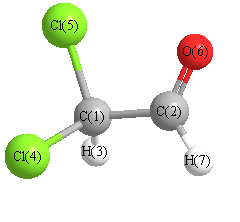Jump to
S1C2
Vibrational Frequencies calculated at CCSD(T)/6-31G**
Geometric Data calculated at CCSD(T)/6-31G**
Electronic energy levels
Charges, Dipole, Quadrupole and Polarizability
Jump to
S1C1
Energy calculated at CCSD(T)/6-31G**
| | hartrees |
|---|
| Energy at 0K | -1071.467482 |
| Energy at 298.15K | |
| HF Energy | -1070.699222 |
| Nuclear repulsion energy | 265.320111 |
The energy at 298.15K was derived from the energy at 0K
and an integrated heat capacity that used the calculated vibrational frequencies.
Vibrational Frequencies calculated at CCSD(T)/6-31G**
| Mode Number |
Symmetry |
Frequency
(cm-1) |
Scaled Frequency
(cm-1) |
IR Intensities
(km mol-1) |
Raman Act
(Å4/u) |
Dep P |
Dep U |
|---|
| 1 |
A |
3167 |
3004 |
|
|
|
|
| 2 |
A |
3036 |
2879 |
|
|
|
|
| 3 |
A |
1815 |
1722 |
|
|
|
|
| 4 |
A |
1431 |
1357 |
|
|
|
|
| 5 |
A |
1305 |
1238 |
|
|
|
|
| 6 |
A |
1278 |
1212 |
|
|
|
|
| 7 |
A |
1050 |
996 |
|
|
|
|
| 8 |
A |
957 |
908 |
|
|
|
|
| 9 |
A |
845 |
801 |
|
|
|
|
| 10 |
A |
663 |
629 |
|
|
|
|
| 11 |
A |
618 |
586 |
|
|
|
|
| 12 |
A |
353 |
334 |
|
|
|
|
| 13 |
A |
281 |
267 |
|
|
|
|
| 14 |
A |
226 |
215 |
|
|
|
|
| 15 |
A |
77 |
73 |
|
|
|
|
Unscaled Zero Point Vibrational Energy (zpe) 8550.2 cm
-1
Scaled (by 0.9485) Zero Point Vibrational Energy (zpe) 8109.9 cm
-1
See section
III.C.1 List or set vibrational scaling factors
to change the scale factors used here.
See section
III.C.2
Calculate a vibrational scaling factor for a given set of molecules
to determine the least squares best scaling factor.
Geometric Data calculated at CCSD(T)/6-31G**
Point Group is C1
Cartesians (Å)
| Atom |
x (Å) |
y (Å) |
z (Å) |
|---|
| C1 |
0.104 |
-0.032 |
0.512 |
| C2 |
-0.727 |
-1.277 |
0.176 |
| H3 |
0.220 |
0.038 |
1.593 |
| Cl4 |
1.743 |
-0.276 |
-0.164 |
| Cl5 |
-0.656 |
1.454 |
-0.057 |
| O6 |
-1.843 |
-1.247 |
-0.299 |
| H7 |
-0.209 |
-2.218 |
0.429 |
Atom - Atom Distances (Å)
| |
C1 |
C2 |
H3 |
Cl4 |
Cl5 |
O6 |
H7 |
| C1 | | 1.5343 | 1.0898 | 1.7893 | 1.7637 | 2.4341 | 2.2093 |
C2 | 1.5343 | | 2.1528 | 2.6867 | 2.7420 | 1.2128 | 1.1029 | H3 | 1.0898 | 2.1528 | | 2.3465 | 2.3446 | 3.0800 | 2.5742 | Cl4 | 1.7893 | 2.6867 | 2.3465 | | 2.9600 | 3.7171 | 2.8159 | Cl5 | 1.7637 | 2.7420 | 2.3446 | 2.9600 | | 2.9603 | 3.7304 | O6 | 2.4341 | 1.2128 | 3.0800 | 3.7171 | 2.9603 | | 2.0345 | H7 | 2.2093 | 1.1029 | 2.5742 | 2.8159 | 3.7304 | 2.0345 | |
 More geometry information
More geometry information
Calculated Bond Angles
| atom1 |
atom2 |
atom3 |
angle |
|
atom1 |
atom2 |
atom3 |
angle |
| C1 |
C2 |
O6 |
124.349 |
|
C1 |
C2 |
H7 |
112.777 |
| C2 |
C1 |
H3 |
109.072 |
|
C2 |
C1 |
Cl4 |
107.626 |
| C2 |
C1 |
Cl5 |
112.299 |
|
H3 |
C1 |
Cl4 |
106.637 |
| H3 |
C1 |
Cl5 |
108.174 |
|
Cl4 |
C1 |
Cl5 |
112.835 |
| O6 |
C2 |
H7 |
122.866 |
|
Electronic energy levels
Charges, Dipole, Quadrupole and Polarizability
